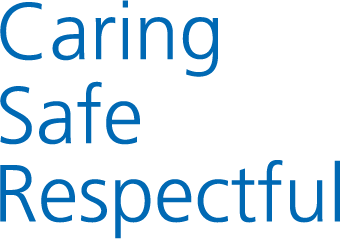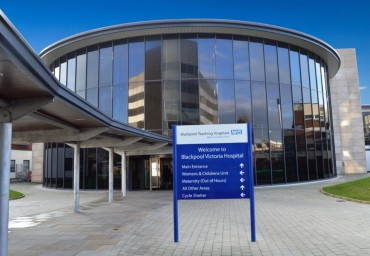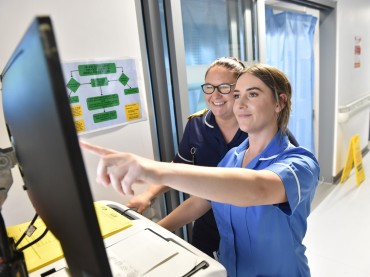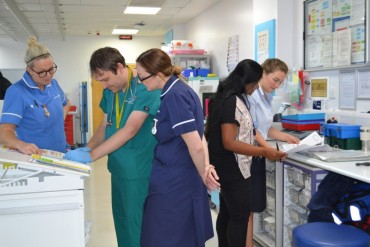CT Scan
CT stands for Computerised Tomography. A CT scan uses X-rays to take detailed pictures of the inside of your body. It helps us find the cause of your problem and guide us to find the best treatment options for you. A standard X-ray does not give the same level of detail as a CT scan. We can scan just about any part of the body, from head to toe. We can even assess the heart, the coronary arteries and the large vessels that bring blood to and from the heart with this type of scan!
CT ScannerThe CT scanner is the ‘doughnut’ shaped scanner and not the tunnel.
In our experience, patients do not feel claustrophobic while having a CT scan because their head is outside of the scanner for most of the examination.
Head CT
A head CT may be done to detect effects of trauma, abscesses, tumours, birth defects, sinus problems, blood vessels or to find the cause of headaches, weakness or a change in mental status.
Neck CT
A neck CT checks the soft tissues of the neck and is frequently used to study a lump or mass in the neck or to look for enlarged lymph nodes or glands.
Chest CT
A CT of the chest is frequently used to further study an abnormality seen on a plain chest X-ray. It is also often used to look for enlarged lymph nodes. We might be looking at the vasculature in your chest to rule out a blood clot or an aneurysm.
Abdominal CT
An abdominal CT scan offers images of the internal organs, bones, soft tissue and blood vessels of the belly area. This procedure is typically used to help diagnose the cause of abdominal or pelvic pain and diseases of the internal organs, small bowels and colon. It is also performed to guide biopsies and drain abscesses, plan for and assess the results of surgery and stage, plan and properly administer radiation treatments for tumours.
Virtual colonoscopy
CT colonography, also known as virtual colonoscopy, uses low-dose radiation scanning to obtain an interior view of the colon (large bowels) that is otherwise only seen with a more invasive procedure where a small camera is inserted to the rectum and passed through the entire colon (endoscopy).
The major reason for performing this examination is to screen for polyps or cancers in the large bowels. The goal is to find these growths in their early stages so that they can be removed early.
We recommend that you eat only a light meal before your scan, but do continue to take any prescribed medication. If you are taking medicines for diabetes (for example metformin), these may need to be altered around the time of your scan. It is important that there is no metal on your clothing, as it may obscure details of your organs, so if possible please try and come to your appointment wearing leisure clothes, for example tracksuit, leggings, etc. If this is not possible, changing facilities and hospitals gowns are available. Contact your GP or please feel free to telephone us on 01253 306619 if you have any questions about your medications.
We also suggest to bring along a list of your medications that you are taking. This helps us better to optimise your scan to your needs.
The bowel-cleansing regimen for CT colonography is similar to that for a colonoscopy. Your diet will be restricted to clear liquids the day before the examination. It is very important that your colon is cleaned out the night before your examination so that the radiologist can clearly see any polyps that might be present. You will be asked to take laxatives as well.
CT scans are a very low-risk procedure.
CT scans use X-rays and are associated with radiation, however the dose we use is very small and the modern machines we use are very efficient to reduce the dose even more. The benefits of the scan are thought to outweigh any risks.
Sometimes we need to give you an injection of contrast dye before the scan in order to see your internal organs better. This contains iodine, which some people are allergic to. Before your scan, we will check whether you’ve had any previous allergies or have had any problems with your thyroid gland.
Any time an injection is done into a vein, there is a risk of the contrast leaking outside the vein under the skin. If a large amount of contrast leaks under the skin, in rare cases, this can cause the skin to break down.
The room where the machine is will be cold. This is so that the scanner doesn’t overheat. We perform approximately 60 CT examinations daily, and the machines certainly do get warm doing so.
It is very important that you remain still throughout the scan. If you find it difficult or uncomfortable lying still, please tell the Radiographer. The Radiographer will monitor you at all times and you will be able to communicate via an intercom.
If you feel short of breath or like you might have to vomit, please let a Radiographer know.
Head CT – When you arrive, report to X-ray Central Reception (Area 4) or the Cardiac Care Centre (Area 12). You will be taken to the scan room and positioned on the scan table so that your are comfortable.
The appointment may take about 10-20 minutes. The scan itself is very short. If you need an injection of contrast dye, one of the CT staff will insert a small needle into a vein in the back of your hand or the crook of your arm. When the dye is injected, you might feel somewhat dizzy, have a hot flush and/or get a metallic taste in your mouth. This is normal! Sometimes people also have a sensation that they are weeing (but they don’t actually do it). These sensations pass within minutes.
The Radiographer will position you and then step into an adjoining room to operate the machine, but will able to hear you via an intercom and see you through a window.
Neck CT – When you arrive, report to X-ray Central reception (Area 4) or the Cardiac Care Centre (Area 12). You will be taken to the scan room and positioned on the scan table so that your are comfortable
The appointment will take about 10-20 minutes, but the scan itself is at the most about five minutes. You will be asked not to swallow during the scan so that the images are in focus. If you need an injection of contrast dye, one of the CT staff will insert a small needle into a vein in the back of your hand or the crook of your arm. When the dye is injected, you might feel somewhat dizzy, have a hot flush and/or get a metallic taste in your mouth. This is normal! Sometimes people also have a sensation that they are wetting the bed (but they don’t actually do it). These sensations pass within minutes.
Chest CT – When you arrive, report to X-ray Central reception (Area 4) or the Cardiac Care Centre (Area 12). You will be taken to the scan room and positioned on the scan table so that your are comfortable
The appointment will take about 10-20 minutes, but the scan itself is at the most about five minutes. We will ask you to hold your breath for up to 20 seconds during the scan so that the images are in focus.
If you need an injection of contrast dye, one of the CT staff will insert a small needle (cannula) into a vein in the back of your hand or the crook of your arm. When the dye is injected, you might feel somewhat dizzy, have a hot flush and/or get a metallic taste in your mouth. This is normal! Sometimes people also have a sensation that they are wetting the bed (but they don’t actually do it). These sensations pass within minutes.
Abdomen CT – When you arrive, report to X-ray Central Reception (Area 4) or the Cardiac Care Centre (Area 12). You will be taken to the scan room and positioned on the scan table so that your are comfortable
The appointment will take about 10-20 minutes, but the scan itself is at the most about five minutes. We will ask you to hold your breath for up to 20 seconds during the scan so that the images are in focus.
You may be given some water to drink or a drink called Gastrografin during the hour before your scan to give a clear outline of your stomach and intestine on the CT scan. This extra time is allowed for in your appointment time. If you need an injection of contrast dye, one of the CT staff will insert a small needle into a vein in the back of your hand or the crook of your arm. When the dye is injected, you might feel somewhat dizzy, have a hot flush and/or get a metallic taste in your mouth. This is normal! Sometimes people also have a sensation that they are wetting the bed (but they don’t actually do it). These sensations pass within minutes.
Virtual Colonoscopy – When you arrive, report to X-ray Central reception (Area 4) or the Cardiac Care Centre (Area 12). You will be taken to the scan room and positioned on the scan table so that your are comfortable.
The appointment will take about 10-20 minutes. We will ask you to hold your breath for up to 20 seconds during the scan so that the images are in focus.
A very small, flexible tube will be inserted into your rectum to allow air to be gently pumped into the colon. This is done so that the bowels are expanded to reduce any folds or wrinkles that might hide smaller polyps. If you need an injection of contrast dye, one of the CT staff will insert a small needle into a vein in the back of your hand or the crook of your arm. When the dye is injected, you might feel somewhat dizzy, have a hot flush and/or get a metallic taste in your mouth. This is normal! Sometimes people also have a sensation that they are wetting the bed (but they don’t actually do it). These sensations pass within minutes.
In most cases, once the scan is completed, you will be able to go home or back to the ward if you are an inpatient. You can eat, drink and go back to your normal activities straight away.
You might have a sense of fullness when the colon is inflated with air, and you might feel the need to pass gas.
If you have received a contrast dye injection, you may need to wait 10 minutes before you can go.
The results of your scan will not be available the same day, but a copy of them will be sent to your Consultant.



